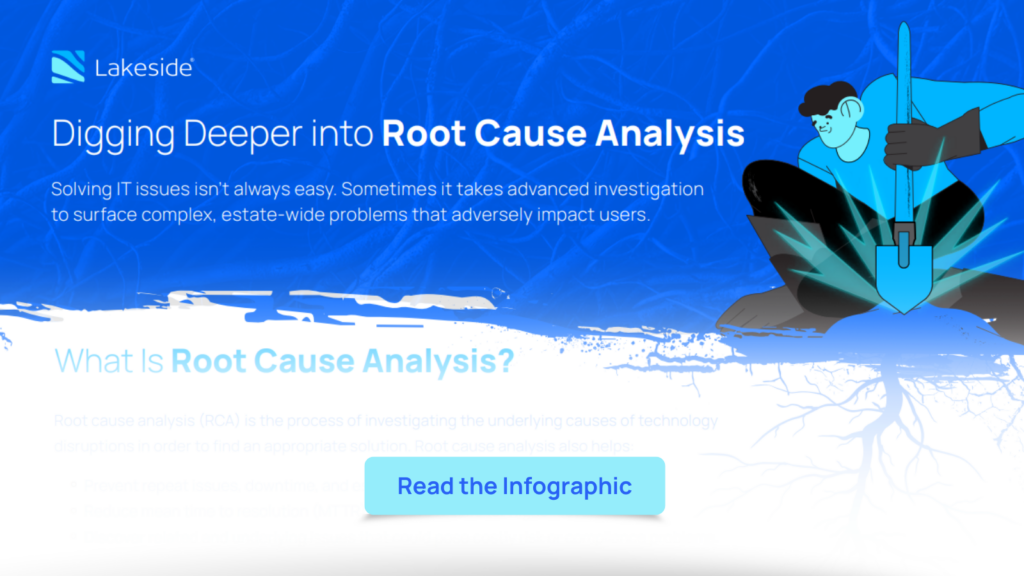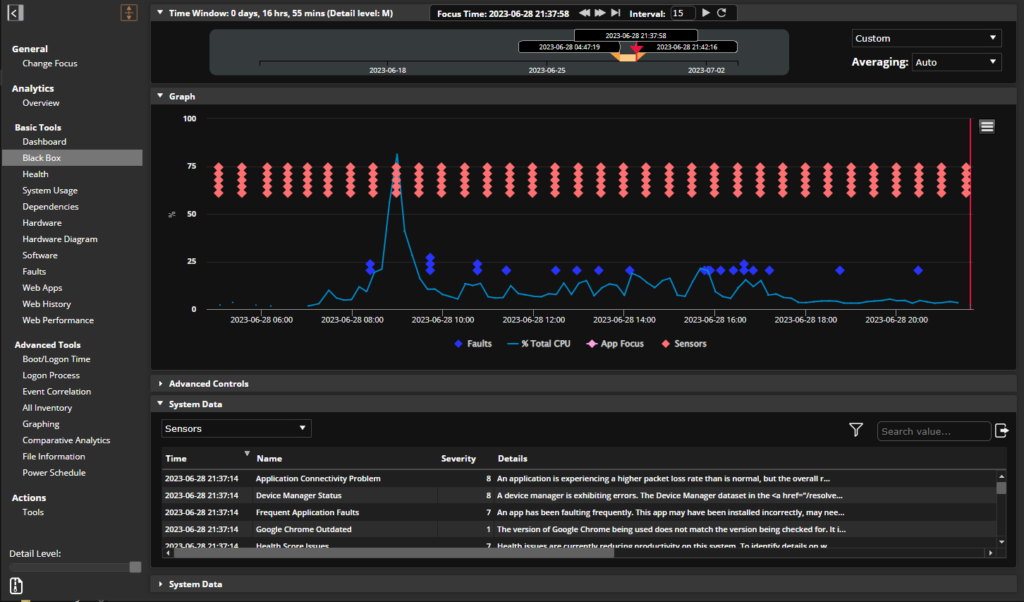
Your guide to the choosing the right root cause analysis solution that will accelerate incident detection and effective remediation
This is the last in a three-part series exploring ways IT can upgrade its root cause analysis strategy, and criteria for evaluating and deriving the most value out of RCA tools. Learn more by reading the first part and second part, or by visiting Lakeside’s root cause analysis page.
Root cause analysis (RCA) tools play a critical role in building efficient digital workplaces because they enable organizations to streamline IT processes, minimize downtime, and improve the digital employee experience (DEX).
Only questions is: How can organizations find the right RCA tools for their needs?
Here’s a quick guide for how to evaluate and choose the best tool for your IT environment.
The Value of Root Cause Analysis Tools
Root cause analysis is traditionally used for problem-solving. IT teams rely on this method to determine why an incident or failure happened by investigating its causes instead of simply treating its symptoms. RCA answers questions such as:
- What happened?
- When did the incident start?
- How and why did it happen?
- What can be done to prevent the problem from happening again?
With RCA tools, IT can quickly identify the source of technology-related issues, spot causal interdependencies, and delve into actionable insights that can lead to swifter remediation. Faster root cause resolution is critical to enhancing users’ digital experiences and their overall satisfaction with the support desk team. In fact, two-thirds of the IT staff surveyed by Lakeside Software indicated that RCA is the most valuable use case for digital experience management.
Well-known RCA methods include:
- Fishbone diagram: A cause-and-effect diagram that looks like a fish skeleton by depicting different causes (bones) leading to a problem (fish head).
- Fault tree analysis (FTA): A diagram that looks like a tree, beginning with a problem and then illustrating potential causes as its branches.
- Five whys: A process that looks into the source of an issue by repeatedly asking “why” to the answers received.
In the IT world, RCA solutions are increasingly relying on artificial intelligence (AI) and data analytics to accelerate cause investigation and remediation. Artificial intelligence for IT operations (AIOps) applies machine learning and analytics to big data, which helps to automate tasks and processes. When evaluating root cause tools, it’s important to take into account their AI capabilities.
Q&A FEATURE
Making the Business Case for Root Cause Analysis
Featuring Forrester Senior Analyst Andrew Hewitt
Questions to Ask When Choosing Tools for Root Cause Analysis
When choosing the right RCA software, organizations should ask:
- Is this RCA tool focused on a single point causation?
- Is this solution able to offer contextual and historical visibility into the root causes of a problem?
- Is this root cause solution capable of providing automated fixes?
These questions are especially important when evaluating RCA tools for IT environments that have become increasingly complex due to digital transformation trends, including multi-cloud infrastructure, bring-your-own-device (BYOD) culture, and dispersed workforces. For IT, this means a greater volume of different locations, infrastructure, and support desk scenarios to manage. For remote workers, there’s an increased reliance on digital devices and web applications to get their jobs done.
Efficient troubleshooting is critical to minimize downtime and improve digital employee experience and engagement in these kinds of environments. As noted by Forrester, 30% of the factors influencing employee engagement are associated with technology.
Key Features of Complete RCA Solutions
For a complete understanding of root causes across the entire IT estate, organizations need solutions that are complete, too, going beyond single-point causation, such as device performance or software-as-a-service (SaaS) outages. An effective RCA tool needs to show the full contextual picture of what is causing the incident. And to do so, it needs deep telemetry data, from both real-time monitoring and historical information.
In a Q&A with Lakeside Software, Forrester senior analyst Andrew Hewitt highlighted the importance of securing support for modern root cause solutions that help prevent repeat issues, accelerate resolution, reduce downtime, and more. Companies should incorporate these tools as part of a strategy that leverages data-driven insights to build proactive and cost-effective IT operations.
“Organizations should look for three primary characteristics when evaluating tools and solutions that can support root cause analysis: holistic, fast, and scalable.”
Andrew Hewitt, Senior Forrester Analyst
To help you evaluate RCA platforms, here’s a breakdown of what it means to have a holistic, fast, and scalable solution for root cause investigation and remediation:
Why You Need a Holistic Approach to Root Cause
A holistic RCA approach is not limited to one single event or cause. Instead, it takes into consideration the entire picture of the IT estate in order to better understand causation and its ramifications.
To achieve this holistic view, a solution needs deep and broad visibility into user behaviors, device and software performance, network details, cloud infrastructure specifics, and more. That also includes the ability to see both real-time and historical telemetry data.
All this knowledge enables IT to identify the events causing the incident, make correlations, and draw insights. In other words, a holistic solution shows the full contextual environment around an incident, in addition to all the conditions and previous events that may have influenced it.
What Can You Do with Fast Root Cause Investigation?
Solutions with fast RCA capabilities rely on data-driven AI to diagnose incidents, understand what type of fix would solve the problem, and automate remediation. As a result, IT technicians don’t need to look deep into the platform to resolve incidents.
Look for root cause tools that offer:
- Quick-fix buttons next to an issue on the console.
- Ways to prioritize fixes based on impact on user experience.
What Is a Scalable RCA Solution?
A root cause solution with scalability can execute diagnostics and remediation across the entire IT estate at once, instead of forcing IT to look into individual users or incidents before moving to the next one.
This could mean running RCA across all devices to identify which ones are impacted by the same issues, enabling IT to scale remediation too through mass healing or even self-healing automations.
Is Your Root Cause Solution Holistic, Fast, and Scalable?
Discover how a modern root cause analysis strategy can help your organization. Request a demo.
Subscribe to the Lakeside Newsletter
Receive platform tips, release updates, news and more




